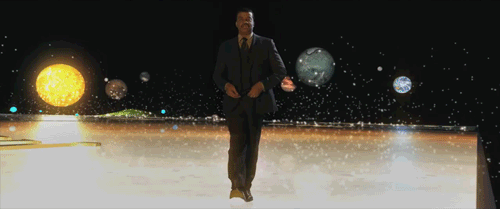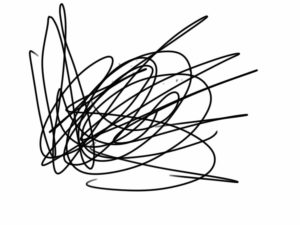
Prompt Images
Physicists have made some pretty bold predictions about the universe over the last hundred or so years: antimatter, black holes, dark matter. But perhaps the boldest comes from string theory*, which currently claims that the universe has 10 dimensions: nine spatial dimensions and one time dimension. If you are keeping track, that is six more spatial dimensions than we all learned about in high school.
This fact alone should be enough to kill string theory, right? If a cartographer came to you and explained she’d created an amazing and unique map of Earth, but the map included four different Americas, it would be reasonable to tell that cartographer to find a new hobby. Shouldn’t folks with some sense of sanity already have explained to physicists that their elegant 10-dimensional theory can’t describe our universe, because our universe only has three spatial dimensions?
An Early History of Dimensions
The concept of “dimensions of space” apparently goes back to the Greeks. Aristotle wrote, “the line has magnitude in one way, the plane in two ways, and the solid in three ways.” And to the question—could there be more dimensions?—Aristotle answered “beyond these there is no other magnitude because the three are all.” Nope, there can’t be more than three dimensions. Why?
Because the three are all.
That awe-inspiring logic harkens to your mother’s equally reasonable “because I said so.”
Starting around 1400 AD, some defied Aristotle’s decree, daring to wonder whether geometry could have more than three dimensions. But because it was the Middle Ages, these suggestions were met with pure ridicule. The mathematician John Wallis called objects of more than three dimensions “monster in nature, less possible than a chimera or a centaure… Length, Breadth and Thickness, take up the whole of space. Nor can fansie imagine how there should be a fourth local dimension beyond the three.”
It took another few hundred years, but eventually mathematicians discovered spaces with more than three dimensions. Not only did they figure out how to add one extra dimension—they figured out how to add any arbitrary number of dimensions. As many dimensions as they wanted.
So how did they fansie to imagine such a thing?
How To Make Your Own Higher Dimensional Universe
Imagine a line. Now imagine extending that line into another dimension to make a plane. Then imagine extending that plane into another dimension to make a cube. So far, so good, right?
Now, imagine extending that cube into another dimension to make a hypercube (a four dimensional cube).
Right. Seems impossible.
Now let’s leave geometry for a moment and turn to an exercise in algebra.
- Start with an equation of one variable (x): 3x = 1.
- Now imagine creating a similar equation with two variables (x and y): 3x + 2y = 1.
- Turns out you can throw in a z too, if you are so inclined: 3x + 2y + 4z = 1.
Point being, it’s much easier to add new variables to an algebraic equation than it is to add new dimensions to some geometric object. Because our understanding of algebra isn’t confined by our spatial reasoning the way our understanding of geometry (historically) has been.
So why does this matter? Well, Aristotle and medieval mathematicians like John Wallis didn’t appreciate that algebra and geometry are deeply connected. But today’s mathematicians do. Consider the equation 3x + 2y = 1 from above—it’s an equation for a line in the x-y plane. The equation 3x + 2y + 4z = 1? That’s an equation for a plane in a three-dimensional space labeled with the coordinates x, y, and z.
Any guesses about the equation 3x + 2y + 4z + 5w = 1? That would be an equation for a three-dimensional hyperplane in a four-dimensional space labeled with the coordinates x, y, z, and w.
No worries if you aren’t getting all this.
My point here is that somewhere along the way mathematicians realized you could write down algebraic equations to describe geometric objects, including “space” itself. Even notions like “line A is perpendicular to line B” could be translated into more equations.
Once you get the hang of the math adding new dimensions to space becomes as easy as throwing some new letters into the geometric pot.
Unfortunately, you can’t simply draw these new dimensions in a way that matches our intuition, because our intuition is tuned to three dimensions. But you can write down perfectly logical rules for creating and manipulating objects of any dimension you’d like.
Now you may be thinking—just because we can define the abstract idea of a higher dimensional space doesn’t mean that our universe has more than three dimensions. Aristotle is still correct if you read him as saying, “the three are all (at least, in our world).”
Or is he?
The Fourth Dimension
The fourth dimension of our universe comes not from considering an additional dimension of space, but from reconceiving of time as a dimension of its own. I won’t go over the history of how this came about, but it’s important to know that Einstein wasn’t the first person to think about time as a new dimension—he just capitalized on it better than anyone before him. In fact, in his original paper on Special Relativity, where Einstein “united” space and time, he still mostly treated space and time as separate things, albeit now intimately related.
It was mathematicians (not physicists) of the time, including Einstein’s former professor Hermann Minkowski, who developed a full-blown model of four dimensional spacetime. In so-called Minkowski space every “event” in the universe is represented as a point with four coordinates: three coordinates representing the location of the event in physical space and the fourth coordinate representing the location “in time.”
Truth be told, physicists had already grown used to thinking of time as another coordinate along with x, y, and z. So in some sense they’d conceived of time as another dimension long before Einstein came along. But before relativity joining time and space felt clunky and forced—the physics equivalent of the marriage between Michael Jackson and Lisa Marie Presley. Einstein showed physicists that this previously awkward union was in fact completely natural.
The Fifth Dimension
It turns out the fourth dimension was like a “gateway dimension.” By which I mean physicists weren’t content to just play around in Minkowski space, or even the more exotic four dimensional spaces that would be discovered lurking in the equations of Einstein’s theory of general relativity. No, once the physicists got a taste of a new (and real) dimension, they started jonesing for more.
Thus was eventually born Kaluza-Klein theory—which took Einstein’s four dimensional spacetime and added a fifth dimension.
At this point you might be thinking—I could get on board with thinking of “time” as another dimension, even if it’s a bit gimmicky. But yet another dimension? How?
This is how I imagine we arrived at a fifth dimension:
Physicist A:
If there are five dimensions then I can unify electromagnetism and gravity into a beautiful theory!
Physicist B:
But there are only four dimensions.
Physicist A:
But it would be so useful to have five dimensions.
Physicist B:
But there are only four dimensions.
Physicist A:
Oh wait! What if the dimension was so small that you didn’t notice when you were moving through it?
Physicist B:
How can a dimension be small? It’s just a direction extending to infinity.
Physicist A:
Shit, you are right.
Physicist B:
Sorry, sounds like it would have been a cool theory.
Physicist A:
Wait! It’s a circle. The tiny dimension is a circle. It doesn’t go off to infinity. You just do loopy-dee-loops around it, but it’s so small you don’t know you are looping through it.
Physicist B:
Huh? A tiny circular dimension? Loopy-dee-loops? Do you realize how absurd that…
Physicist A shows Physicist B some math about this tiny circular dimension.
Physicist B:
OK, I’ll buy it.
I realize this doesn’t help explain the fifth dimension completely. If you want that explanation, search for it on Google. I’m sure there’s a gazillion sites showing you how to “visualize” tiny curled up dimensions in space. For our purposes it suffices to tell you that someone sold other physicists on this idea and after that all hell broke loose.
From Five to Twenty Six… and Back to Ten
If Kaluza-Klein theory, with its new spatial dimension, had delivered a shot of morphine into the veins of theoretical physics, string theory arrived like a dose of fentanyl. That’s because string theory, as originally formulated, didn’t just posit one or even two “extra” dimensions. No, string theory prior to the 1980s postulated 22 extra dimensions, for a grand total of 26.
Physicists are not known for their sales or marketing expertise, so can you imagine publishing the paper that had to sell the rest of the physics community on 22 new dimensions?
Kaluza and Klein were onto something with their extra dimension, but they stopped short of taking that idea to its logical conclusion… adding 21 additional new dimensions.
Decades later, physicists came to their senses and realized they only needed an extra six dimensions.
Can you imagine publishing the paper that had to explain how you overshot the number of new dimensions required by 16?
Of course, at the time it only seemed natural that the universe have twenty six dimensions… it’s only with hindsight that we can see that 16 of those extra 22 dimensions were completely unnecessary…
And this, my dear reader, is how we got from a three-dimensional universe to the idea of a 10-dimensional universe in the course of about 100 years. It’s obvious now that 10 is the most natural number [**] and that of the nine spatial dimensions of our universe, three should be large and six should be microscopic in size and curled up into something called a Calabi-Yau manifold.
How can we be so sure? Because the ten are all.
Let’s Not Get Greedy
The thing is, even if string theory is entirely wrong, we could still have extra dimensions. String theory requires the universe to have extra dimensions, but a universe with extra dimensions doesn’t require string theory.

Such a universe, with perhaps five dimensions, or six dimensions, or 134 dimensions, might be described by some other theory we have yet to discover.
Personally I’d be glad for scientists to discover just one extra dimension. And I don’t care if it’s straight, circular, or shaped like my 4 year-old’s drawing of an elephant:

See the big ears and the trunk?
I’d just be happy to have something proving yet again that universe is stranger than we imagined.
Footnotes:
[*] To be very clear here – string theory is very much a theory in the pejorative sense used by creationists when they say evolution “is just a theory.” It paints a very compelling argument (according to the string theorists, anyways) – but there’s literally zippy experimental evidence for it at the present.
[**] Actually, 10 dimensions is one possibility. There is another theory called M-theory, which is like string theory on steroids that predicts 11 dimensions. So is it 10 or 11 dimensions? According to string theorists, it’s like tomato/tomato (which admittedly doesn’t translate well to text) because the concept of dimension is “fluid” in string theory. Call me old fashioned, but I’m just not comfortable with the number of space-time dimensions existing on a spectrum.



